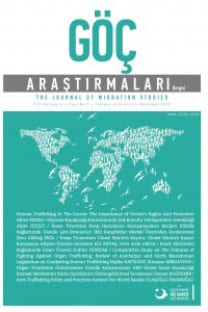Uluslararası Standartlara Uyum: Birleşik Krallık ve Çocukların İdari Gözetimi
Çocuk idari gözetimi, Göç Hukuku, Uluslararası İnsan Hakları Standartları, Akkültürasyon Teorisi
A Story of Compliance with International Standards: The United Kingdom and Immigration Detention of Children
Immigration detention of children, Immigration Law, International Human Rights Standards, Acculturation Theory,
___
- (http://focus-migration.hwwi.de/United-Kingdom.2708.0.html?&L=1, 01.02.2017).
- (http://search-material.parliament.uk/, 15.01.2017).
- (http://www.ons.gov.uk/ons/rel/census/2011-census-analysis/immigration-patterns-and-characteristics-of-non-uk-born-population-groups-in-england-and-wales/summary.html, 22.01.2017).
- Abbott, D. (2007), House of Commons, 467 c41-3WH.
- Abbott, D. (2010), House of Commons, 511 c222-3WH.
- Bail for Immigration Detainees (2009), Briefing paper on children and immigration detention, London.
- Bevan, V. (1986), The Development of British Immigration Law, Croom Helm, Kent.
- Browne, J. (2007), House of Commons, 20 November, 467 c53-4WH.
- Burnett, J., Carter, J., Evershed, J., Kohli, M. B., Powell, C. & Wilde, G. (2010), “State Sponsored Cruelty: Children in Immigration Detention”, Medical Justice, London.
- Cohen, R. (1994), Frontiers of Identity, Longman Publishing, New York.
- Cole, E. K. H. (2003), “A few families too many: The detention of asylum-seeking families in the UK”, Bail for Immigration Detainees, London.
- Committee on the Rights of the Child (2002), Concluding Observations of the United Kingdom, CRC/C/15/Add.
- Committee on the Rights of the Child (2008), Concluding Observations of the United Kingdom, CRC/C/GBR/CO/4.
- Crawley, H. & Lester, T. (2005), “No Place for a Child: Children in immigration detention: Impacts, alternatives and safeguards”, Save the Children, London.
- d’Orey, S. (1984), Immigration Prisoners: a Forgotten Minority, Runnymede Trust, London.
- Flynn, D., Ford, R. & Somerville, W. (2010), “Immigration and the Election”, Renewal, Volume 18 Number ¾, p. 102-114.
- George. A. L. & Bennett, A. (2005), Case Studies and Theory Development in the Social Sciences, MIT, Cambridge.
- Gerring, J. (2004), “What Is a Case Study and What Is It Good for?”, American Political Science Review, Volume 98 Number 2, p. 341-354.
- Gil-Robles, A. (2005), Report by the Commissioner for Human Rights on his visit to the UK, CommDH(2005)6.
- Gilham, B. (2000), Case Study and Research Methods, Biddles, Norfolk. Goodman, R. & Jinks, D. (2013), Socializing States: Promoting Human Rights through International Law, Oxford University Press, New York.
- Hammarberg, T. (2008), Report by the Commissioner for Human Rights on his visit to the UK, CommDH(2008)23.
- Hansard Archives, HC Deb 16 March 2000 vol 346 cc262-4W.
- Hansard Archives.
- Her Majesty’s Inspectorate of Prisons for England and Wales (2002), An Inspection of Dungavel Immigration Removal Centre.
- Her Majesty’s Inspectorate of Prisons for England and Wales (2004), Report on an unannounced inspection of Dungavel House Immigration Removal Centre.
- Her Majesty’s Inspectorate of Prisons for England and Wales (2006), Report on an announced inspection of Dungavel House Immigration Removal Centre.
- Home Office (1996), Asylum Statistics, Table 1.1.
- Home Office (2006), Asylum Statistics.
- Human Rights Committee (1995), CCPR/C/79/Add. 55.
- Human Rights Watch (2010), Fast-Tracked Unfairness: Detention and Denial of Women Asylum Seekers in the UK.
- Independent Asylum Commission (2008), Deserving Dignity, London.
- Independent Asylum Commission (2008), Safe Return, London.
- Independent Asylum Commission (2008), Saving Sanctuary, London.
- Lord Avebury (2007), House of Lords, 12 July, 694 c166-8GC.
- Lord Avebury (2007), House of Lords, 23 July, 694 c154-5GC.
- Malmberg, M. (2004), “Control and Deterrence Discourses of detention of asylum-seekers”, Sussex Migration Working Paper no. 20, Sussex Centre for Migration Research.
- McClean, D. (2010), “Immigration and Asylum in the United Kingdom”, Ecclesiastical Law Society, Volume 12, Number 2, p. 152-161.
- Meyers, E. (2004), International Immigration Policy: A Theoretical and Comparative Analysis, Palgrave Macmillan, New York.
- Samuels, H. (1997), “Administrative detention in immigration cases: the Hardial Singh principles revisited”, Public Law, 1997, Winter, p. 623-629.
- Schuster, L. (2003), The use and abuse of political asylum in Britain and Germany, Cass series: British politics and society, Frank Cass, London.
- Shutter, S. (1992), “Immigration and Nationality Law Handbook”, Joint Council for the Welfare of Immigrants, London.
- Silverman, S. J. (2012), ““Regrettable but Necessary?” A Historical and Theoretical Study of the Rise of the U.K. Immigration Detention Estate and Its Opposition”, Politics & Policy, Volume 40 Number 6, p. 1131-1157.
- Silverman, S. J. & Hajela, R. (2013), Briefing: Immigration Detention in the UK, The Migration Observatory, University of Oxford. Somerville, W. & Cooper, B. (2009), “Immigration to the United Kingdom”, Segal, U. A., Elliot, D. & Mayadas, N. S. (Ed.), Immigration Worldwide: Policies, Practices and Trends, Oxford Scholarship Online, Chapter 9.
- The Children’s Commissioner (2009), The Arrest and Detention of Children Subject to Immigration Control: A Report Following the Children’s Commissioner for England’s visit to Yarl’s Wood Immigration, 11 Million, London.
- The Joint Committee on Human Rights (2007), The Treatment of Asylum Seekers, 10th Report of Session 2006-07.
- UK Border Agency (2000), Operational Enforcement Manual.
- UK Border Agency (2008), Enforcement Instructions and Guidance, Chapter 55.9.4 Families.
- UK Border Agency (2009), Immigration Directorates' Instructions, Chapter 31 Section 1 - Detention and Detention Policy in Port Cases, para. 10.A.2. Young Persons.
- UK Border Agency (2010), Enforcement Instructions and Guidance, Chapter 55.9.4. Families with children under the age of 18.
- UK Border Agency (2010), Review into Ending the Detention of Children for Immigration Purposes.
- Welch, M. & Schuster, L. (2005), “Detention of asylum seekers in the US, UK, France, Germany, and Italy: A critical view of the globalizing culture of control”, Criminal Justice, Volume 5 Number 4, p. 331-355.
- Woolas, P. (2010), House of Commons, 18 January, 504 c33W, 310109.
- Yin, Robert K. (2014), Case Study Research: Design and Methods, Sage Publications, California, 5th. Edition.
- ISSN: 2149-5548
- Başlangıç: 2015
- Yayıncı: Göç İdaresi Genel Müdürlüğü
Türkiye'deki Suriyeli Mültecilerin İşgücü Piyasası Entegrasyonu: Mültecilikten Göçmenliğe
Çağdaş Japonya’da Yeni Göçmenlik Politikasına Öncülük Etme
Uluslararası Standartlara Uyum: Birleşik Krallık ve Çocukların İdari Gözetimi
Göç ve Entegrasyon Politikalarında Vatandaşlık
Entegrasyonun Politika Amaçlarına Ulaşmada Avusturalya'daki Mülteci Krizinin Ele Alınması
Sherene OZYUREK, Maurice GERKENS
Fransız Kamusal Alanında Bütünleşme Stratejisi
